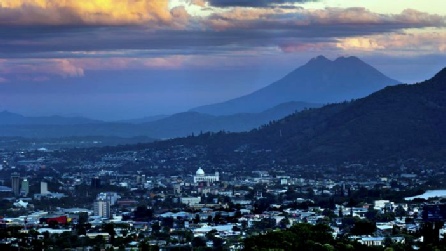





El Salvador, officially the Republic of El Salvador (Spanish: República de El Salvador, literally "Republic of The Savior"), is the smallest and the most densely populated country in Central America. El Salvador's capital and largest city is San Salvador. As of 2015, the country had a population of approximately 6.38 million, consisting largely of Mestizos of European and Indigenous American descent.
El Salvador was for centuries inhabited by several Mesoamerican nations, especially
the Cuzcatlecs, as well as the Lenca and Maya. In the early 16th century, the Spanish
Empire conquered the territory, incorporating it into the Viceroyalty of New Spain
ruled from Mexico City. In 1821, the country achieved independence from Spain as
part of the First Mexican Empire, only to further secede as part of the Federal Republic
of Central America in 1823. Upon the republic's dissolution in 1841, El Salvador
became sovereign until forming a short-
From the late 19th to the mid-
El Salvador's economy was historically dominated by agriculture, beginning with the indigo plant (añil in Spanish), the most important crop during the colonial period, and followed thereafter by coffee, which by the early 20th century accounted for 90 percent of export earnings. El Salvador has since reduced its dependence on coffee and embarked on diversifying the economy by opening up trade and financial links and expanding the manufacturing sector. The colón, the official currency of El Salvador since 1892, was replaced by the U.S. dollar in 2001.
As of 2010, El Salvador ranks 12th among Latin American countries in terms of the Human Development Index and fourth in Central America (behind Panama, Costa Rica, and Belize) due in part to ongoing rapid industrialisation. However, the country continues to struggle with high rates of poverty, inequality, and crime.
El Salvador's population was 6,377,195 in 2015, compared to 2,200,000 in 1950.[88] In 2010 the percentage of the population below the age of 15 was 32.1%, 61% were between 15 and 65 years of age, while 6.9% were 65 years or older.[88]
The capital city of San Salvador has a population of about 2.1 million people. An estimated 42% of El Salvador's population live in rural areas. Urbanization has expanded at a phenomenal rate in El Salvador since the 1960s, with millions moving to the cities and creating associated problems for urban planning and services.
El Salvador's population is composed of Mestizos, whites, and indigenous peoples.
Eighty-
| Belizean cuisine |
| Guatemalan cuisine |
| Salvadoran Cuisine |
| Honduran Cuisine |
| Nicaraguan cuisine |
| Costa Rican Cuisine |